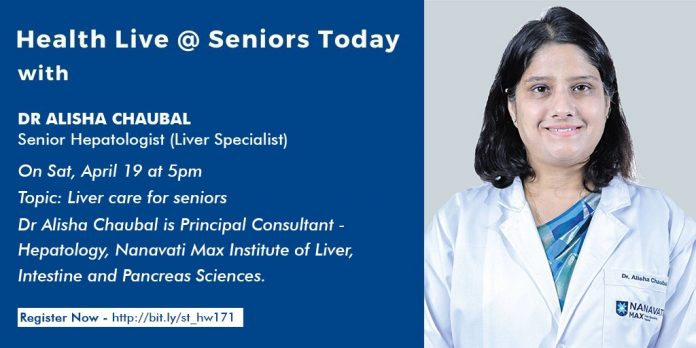On 19 April, 2025, Seniors Today hosted their weekly Health Live Webinar with a Senior Liver Specialist, Dr Alisha Chaubal who spoke on and answered questions about Liver Care for Seniors.
Dr Alisha Chaubal is the Principal Consultant- Hepatology at the Nanavati Max Institute of Liver, Intestine and Pancreas Sciences.
A healthy liver looks shiny and brown. Whereas, when fat starts depositing on the liver, it becomes yellow and appears swollen- this is what is called a fatty liver.
If it is more than 5% fat accumulation on the liver, it is called fatty liver.
India has become the diabetic capital of the world. We are also inching towards becoming the fatty liver capital of the world. More than 30% of our population has a fatty liver.
A study was done in southern India and it was found that nearly 60-70% of the individuals had a fatty liver.
On ultrasonography, some of us may have been diagnosed with fatty liver. It may also have remarks such as grade- 1 fatty liver, grade- 2 fatty liver, grade- 3 fatty liver.
When fat initially starts accumulating over a fatty liver, it is called steatosis.
Once the fat has accumulated on the liver, it is called NASH (Non Alcoholic Steatohepatis) where the fat starts injuring the liver. In this stage, the liver enzymes can get deranged and your blood tests may start showing slight elevated SGOt and SGPT (liver enzymes).
This injured liver starts to become stiff and leads to liver cirrhosis.
The last stage is liver cancer.
30% of the general population will have a fatty liver. Of which, 30% will lead to developing injury to the liver. Of this 30%, 10% will go ahead to develop liver cirrhosis.
Causes for fatty liver:
- Obesity
- Alcohol consumption
- Drug consumptions such as NSAIDs (pain killer), medication for arthritis.
- Starvation
High risk individuals include:
- Individuals with hypertension, diabetes,
- Individuals who are obese
- Individuals with deranged lipid profile (dyslipidemia)
- Family history of liver cirrhosis and/ or liver cancer
These individuals are at a higher risk and should therefore have themselves tested for fatty liver.
The age to test yourself at is negotiable.
This can be done if you have any symptoms/ problems or after the age of 35 years.
This can also be done during your annual medical checkup.
Not everybody who is fat will have a fatty liver.
What is important is the distribution of body fat.
It is better to have pear kind of obesity, where there is fat accumulation in your hip region rather than having apple kind of obesity where the fat is accumulated near the navel.
Apple kind of obesity is correlated to having more fat around your organs.
Soft measurements of visceral fat:
- Body mass index
- Waist circumference (cut off is 80cm in female and 90cm in males)
- Bio impedance analysis
- Dexa scan
Ways to get yourself tested for fatty liver:
- Blood investigations such as your Hemogram, liver function tests, renal function tests, diabetic profile, lipid profile, thyroid function test and uric acid. However even if your blood tests are normal, you could still have fat over your liver
- Ultrasonography of the abdomen
- Tests for fibrosis are a must in patients with a fatty liver. These include:
- Fibro scan- it is not an invasive test
- MR elastography
- Tests to check your heart and kidneys should also be done to see if it has affected your other organs.
Symptoms of fatty liver:
- No symptoms
- You develop symptoms only when you develop advanced liver disease.
Symptoms of liver cirrhosis:
- Ascitis- accumulation of fluid in your stomach leading to distention of your abdomen
- Blood in stools
- Blood in vomitus
- Liver encephalopathy: liver cirrhosis is not just limited to symptoms because of the liver. You can also have other symptoms such as increased forgetfulness, change in your sleep- wake cycles, mood changes
- Weight loss
- Loss of appetite: more than 5-10 % of loss of weight in less than 3 months
Treatment of fatty liver:
– The only treatment for fatty liver is weight loss. If you lose 7-10% of your weight you can reverse early stages of fibrosis.
- Making special changes in your diet- Mediterranean diet. Prefer fruits with a low glycemic index, vegetables, whole grains, protein
- Regular exercise
You should avoid alcohol completely if you have liver fibrosis or cirrhosis. Otherwise, the recommended amount is 10 gms for males and 7.5 gms of alcohol for females








